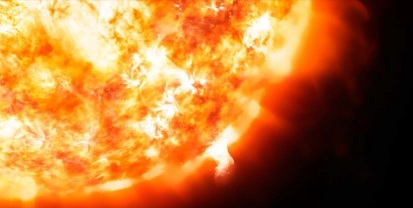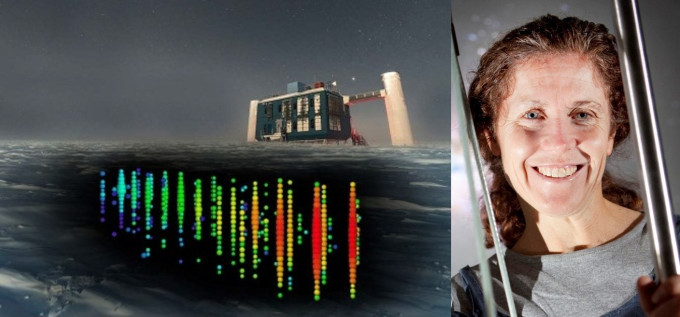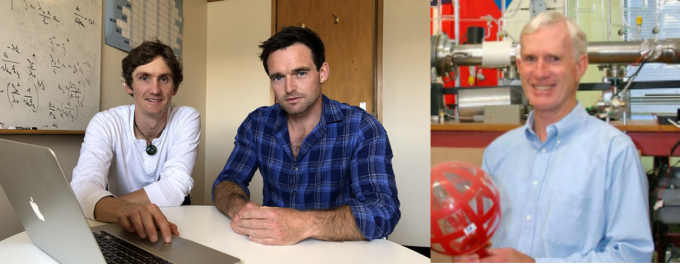Impact story: Bayesian Theory and astrophysics

New Zealand’s space sector grew by more than 50 percent in the five years to 2025 and contributed around 17,000 jobs and approximately $2.5 billion annually to the economy. Exposure to leading international programmes underpins much of this, with most New Zealand researchers having working relationships with companies setting up here.
Projects supported by the Marsden Fund are bringing cutting-edge technology to our shores and providing access to the world’s most sophisticated supercomputers. Software and modelling data being developed here is informing future space missions and providing insights in communication, climate, and space studies to fuel future growth in this sector.
One such cutting-edge project involves Professor Jenni Adams FRSNZ of Te Whare Wānanga o Waitaha - University of Canterbury, whose group is part of a collaboration between more than 350 scientists at 58 institutions around the world which operates the IceCube neutrino observatory.
Suspended from cables deep below the South Pole, this observatory uses more than 5,000 optical sensors to detect neutrinos, observing our galaxy for the first time using particles instead of light. The collaboration achieved a series of breakthrough results discovering astrophysical neutrinos in 2013 and identifying the first source of these neutrinos in 2017. Adams was part of the team to produce the first image of the Milky Way using neutrinos.

(L) Stock illustration: IceCube neutrino observatory and (R) Professor Jenni Adams.
Statistician Professor Renate Meyer of Waipapa Taumata Rau - University of Auckland has pioneered analysis of data from gravitational waves since the 1990s using techniques at the frontiers of physics and statistics to contribute to Laser Interferometer Gravitational-Wave Observatories (LIGO). Meyer’s team collaborates with the European Space Agency and NASA as part of the Laser Interferometer Space Antenna Consortium.
Marsden Funding really made a world of difference. It provided the means to actively engage in international gravitational wave research of the LIGO Scientific Collaboration and to develop a network of collaborators in the USA and Europe.

L to R: Professor Renate Meyer, Caltech illustration gravitational waves black hole merger, and ESA-D.Ducros artist impression Ariane 6.
An Ariane 6 mission is due to launch the space-based Interferometer in 2035. It will be the first gravitational wave detector in space and will enable observations from sources with much larger masses than ground-based interferometers can detect, such as supermassive black holes at the centres of galaxies or the stochastic background from the early evolution of the Universe.
Meyer’s team contribute robust Bayesian nonparametric estimation algorithms and accurate numerical waveform simulations.
“Marsden Funding really made a world of difference,” says Meyer. “It provided the means to actively engage in international gravitational wave research of the LIGO Scientific Collaboration and to develop a network of collaborators in the USA and Europe. It not only provided a springboard for my own academic career but also for the careers of my PhD students.”
Marsden-funded research is revealing the secrets of the Universe in other ways. For example, geochemist Professor Claudine Stirling FRSNZ, Ōtākou Whakaihu Waka - University of Otago, whose work revises the chronology of the early solar system, or Professor Richard Easther, University of Auckland, who explores the origin and interaction of galaxies in the expanding Universe.
Our ability to measure and observe space not only improves our understanding of what lies beyond, it can provide knowledge applicable to our daily world. Research studying solar forces illustrate this well.
Associate Professor Jonathan Squire, University of Otago, says the surface of the Sun starts at 6,000 degrees Celsius, but over a short distance of only a few hundred kilometres, it suddenly heats up to more than a million degrees, becoming its atmosphere, or corona.
“This is so hot that the gas escapes the Sun’s gravity as ‘solar wind’, and flies into space, smashing into Earth and other planets. “We know from measurements and theory that the sudden temperature jump is related to magnetic fields which thread out of the Sun’s surface. But, exactly how these work to heat the gas is not well understood – this is known as the Coronal Heating Problem,” he says.
Squire’s work on plasma, magnetic fields, and astrophysical systems like the solar corona and wind, critically improves our fundamental knowledge of this exotic but widespread form of matter. It lays foundations for understanding its turbulent behaviour and is yielding the first practical techniques for simulating such plasmas, knowledge that is of interest to companies like OpenStar Technologies, a Wellington-based start-up building a prototype for a fusion reactor.

(L) Associate Professor Jonathan Squire and Dr Romain Meyrand, and (R) Professor Murray McEwan.
Squire and University of Otago colleagues communicate and contribute to understanding around plasmas and solar activity, information that could be critical in an extreme solar weather event. Technology initially conceived for space can have surprising applications.
The Marsden funded research of Emeritus Professor Murray McEwan FRSNZ, University of Canterbury, was originally designed to investigate the ion chemistry of planetary atmospheres, instead it led to a fully developed commercial spectrometry solution.
Syft Technologies currently operates in seven countries and offers real-time, direct injection mass spectrometry to worldwide industries ranging from cancer screening and pharmaceutical development, to environmental protection, semiconductor manufacturing, and food flavours.
Other projects inspire wonder. NASA’s Dragonfly mission, which will send a rotorcraft to Saturn’s moon Titan, is scheduled to launch in July 2028 and is expected to arrive at Titan in 2034.
Among its quests it will investigate ‘co-crystals’, informed by the work of Dr Courtney Ennis, University of Otago. Astrobiologists are predicting they will find multicomponent crystal minerals – co-crystals – which could facilitate chemical reactions to create biologically-important compounds like the elementary units of DNA.
Ennis and his team have established a laboratory which mimics the icy surface, atmospheric aerosols, and radiation environment of Titan. Under these conditions co-crystals are expected to form some of the organic chemicals necessary for life to develop. From this, Ennis’s team will be able to offer the Dragonfly mission some molecular clues as to what it will find.

L to R: Dr Courtney Ennis, NASA/John Hopkins artists impression of Dragonfly on Titan, and Professor Jorg Frauendiener.
New Zealand also has a niche in computational gravity – numerical simulations of gravitational systems. Researchers from the University of Otago Gravity Group, including Professor Jörg Frauendiener FRSNZ, Dr Chris Stevens and collaborators explore what phenomena can occur under Einstein’s theory of relativity by not only “tickling” but “punching” a black hole, effectively deforming it by shooting strong gravitational waves onto it and studying the reaction.
“There’s so much more to explore in Einstein’s theories. Most of the energy in research so far has gone on two black holes colliding, but there are other more interesting problems,” says Frauendiener.
While he admits it’s a rarefied field, it’s highly regarded internationally. Frauendiener is President of the NZ Association of von Humboldt Fellows and is proud that New Zealand attracts more Humboldt funding from Germany than any other nation per capita. He notes that there’s a very good story around career progression, and how all his PhD students go on to amazing things.
Career pathways into New Zealand’s space sector are underpinned by access to international research programmes. As well as providing new insights on space and the technologies that enable its observation, the Marsden Fund is investing in a home-grown workforce for international companies to establish here, either in the space sector itself, or related industries in communication, forecasting, and remote sensing.
